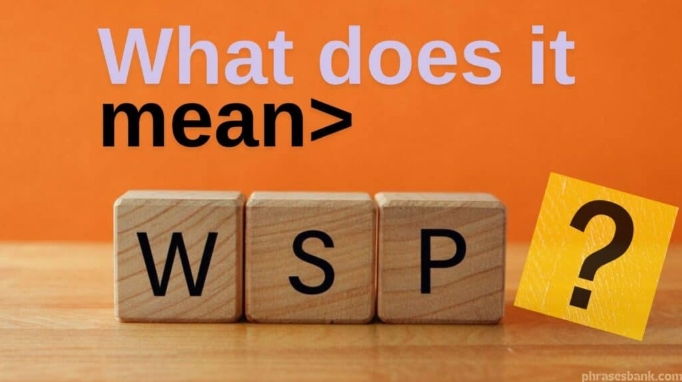WSP meaning is a term you might see a lot in texting and social media chats. Many people ask, “What does WSP mean?” simply because they see it in messages but are not sure about its meaning. WSP is a short form used mostly in casual conversations online. It is often used by friends, teenagers, or social media users who like to keep messages short and quick. Knowing the WSP meaning can help you understand your chats better and even respond more naturally to your friends. This guide will explain everything you need to know about WSP, how it started, and the ways people use it in their daily online conversations.
The WSP meaning is not just one thing. Most of the time, it stands for “What’s up?” which is a friendly way to ask someone how they are or what they are doing. People use it when they greet friends online instead of typing a long message. But WSP can also have other meanings depending on where you see it. For example, in work or technical chats, WSP can mean different things, but in text messages, it is usually casual. Understanding the context is very important. This article will show you all the main meanings of WSP, how to use it in the right way, and some tips so you don’t get confused when chatting online. By the end, you will know exactly what WSP means and how to use it correctly.
WSP Meaning: The Most Common Use Explained
The most common WSP meaning is “What’s up?”. This is a simple greeting used when you talk to friends or people you know online. It is just another way of asking, “How are you?” or “What are you doing?” For example, if your friend messages you “WSP?” they are really asking how you are or what is happening in your life. It is very casual and friendly. People like to use WSP because it is short and easy to type, especially when texting on phones or chatting on social media apps like WhatsApp, Instagram, or Snapchat.
Using WSP in the right way can make your messages look cool and friendly. If someone says “WSP?” you can reply with something simple like “Not much, you?” or “Just chilling, WSP with you?” It keeps the conversation casual and fun. Many young people prefer using WSP instead of full greetings because it saves time and makes chatting faster.
Different Contexts of WSP Meaning
Although WSP usually means “What’s up?” in texting, it can have other meanings depending on the situation. In business or work chats, WSP can refer to technical terms, names of organizations, or services. For example, some companies use WSP as an abbreviation for Water and Sanitation Program or Workplace Safety Plan. In these contexts, WSP is very different from texting and should be understood according to the situation.
When you see WSP in a group chat or social media post, always check who sent it and where. If it is a casual chat with friends, it is probably “What’s up?” If it is in work or professional messages, it might have another meaning. Understanding the context will help you avoid confusion.
How WSP Meaning Started and Became Popular
WSP meaning started as a way for people to text faster. When texting first became popular, people wanted to shorten long words and phrases. “What’s up?” was often typed as WSP to save time. Over time, WSP became very common in social media and texting apps. Today, you can see WSP in almost every chat platform, including WhatsApp, Facebook Messenger, Instagram, and Snapchat.
The rise of online chatting and instant messaging made WSP popular. People like using short forms like WSP because it is quick and friendly. Using WSP can also make your message look modern and casual. Younger generations especially love using WSP because it is trendy.
WSP Meaning in Texting vs Social Media
In texting, WSP is mostly used as a greeting. It is short and easy to type. For example, you can text your friend, “WSP?” and start a conversation without writing a long message. On social media, WSP can also appear in comments, posts, or memes. Here, it is often used to grab attention or start a fun conversation.
Even though WSP is casual, it is important to know when to use it. In texting with friends, WSP is perfect. But in professional messages, emails, or formal conversations, it is better not to use WSP. Using it in the wrong place can make you look careless or informal.
Other Meanings of WSP You Should Know
Besides “What’s up?”, WSP can have other meanings depending on the context:
- Water and Sanitation Program – used in global development or environmental discussions.
- Workplace Safety Plan – used in offices or construction industries.
- Wireless Session Protocol – used in technology or internet discussions.
When Not to Use WSP Meaning in Messages
WSP is great for casual chats but not for all situations. Avoid using WSP in:
- Formal emails or letters
- Professional work messages
- Messages to people you don’t know well
Fun Examples of WSP Meaning in Conversations
Here are some fun ways to use WSP in chats:
- Friend 1: WSP?
Friend 2: Not much, just watching TV. WSP with you? - Friend 1: WSP?
Friend 2: Chilling, want to hang out later?
Tips to Remember the WSP Meaning Easily
- Always remember the context – texting or professional chat.
- Most of the time, WSP = “What’s up?”
- Keep your replies casual when using WSP.
- Avoid using WSP in formal conversations.
- Practice using it with friends to feel natural.
Conclusion
WSP meaning is simple but very useful. Most people use it to say “What’s up?” in casual chats with friends. Knowing its meaning can make texting and social media chatting easier. But remember, WSP can also have other meanings in professional or technical contexts. By understanding the context, you can use WSP correctly and confidently in your messages.
FAQs
Q1: What is the WSP meaning in texting?
A1: In texting, WSP usually means “What’s up?” It is a casual way to greet friends or start a conversation.
Q2: Can WSP mean something else?
A2: Yes, in work, technical, or professional chats, WSP can have other meanings like “Workplace Safety Plan” or “Water and Sanitation Program.”
Q3: Is WSP appropriate for formal messages?
A3: No, WSP is casual and should not be used in professional emails or messages to people you don’t know well.


